Small Farms, Big Challenges
Amy Dowd Bartholomew ’88 does not believe in keeping her patients at arm’s length, so right now her glove-covered arm is all the way inside a cow’s back end feeling for signs of pregnancy. She wears knee-high rubber boots and, depending on the weather, up to seven layers of clothing, including a set of green coveralls.
Bartholomew is a large-animal veterinarian in Franklin County, Vermont, the heart of the state’s dairy industry, and hers might appear to be a career marked by contradiction.
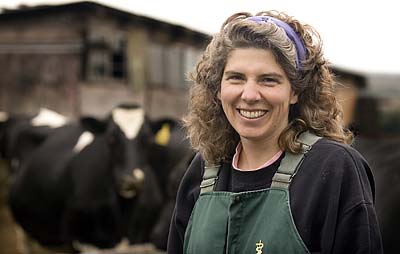
Veterinarian Amy Dowd Bartholomew ’88 has the attention of dairy cows during a typical workday in northern Vermont.
For one, she makes her living from a struggling regional industry. For decades, the number of dairy farms in the Northeast and upper Midwest, especially small operations, has dwindled. “Small Vermont dairy farms are a dying breed,” Bartholomew said. “It is so bad here.”
Yet, vets who focus on dairy and food animals remain very busy. The U.S. dairy industry isn’t disappearing, merely trending toward fewer, larger farms with hundreds of cows. But despite high demand, fewer new vets are choosing to focus on large-animal work, according to a New York Times report last year, instead opting for more profitable (and easier) small-animal work.
It’s no wonder. For a large-animal vet, the hours are long and the conditions can be miserable — 24-hour emergencies happen whether it’s 30 degrees below zero or so warm you can choke on flies — and you never know when you might get run over by an angry cow.
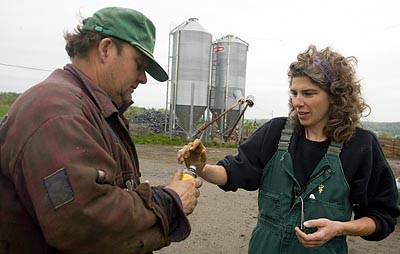
Bartholomew reviews medications with farmer Daniel Lussier at his farm in Sheldon, Vt.
One of Bartholomew’s peers, large-animal vet Nate Harvey ’99, understands the pressures — and the rewards — that keep Bartholomew on the road. When Harvey was growing up in West Newfield, Maine, he loved to visit his grandfather’s dairy farm in Epping, N.H. “I always knew, since I was a little kid tugging on the pants of the vet, that I wanted to be a vet and work with cows,” Harvey said.
He earned his veterinary degree from the University of Pennsylvania School of Veterinary Medicine (as did Bartholomew) and now works in the field for the school’s New Bolton Center, which comprises a large-animal hospital — where the ill-fated racehorse Barbaro was treated — plus a dairy, an aquatic animal lab, and diagnostic labs. Harvey roams the Pennsylvania countryside, working with the cows he loves and teaching vet students and younger vets.
Someday, he says, he hopes to join a dairy practice somewhere between Pennsylvania and Maine. “I like working with live animals,” Harvey said. “I love it when my office is a series of rolling green hills. I like the adventure of getting out there.”
But every year he gets job offers that promise other rewards. A job with the Food Safety and Inspection Service of the U.S. Department of Agriculture, for example, would include a good salary, daytime hours, and good working conditions.
“You get every single holiday off,” he mused. “Private practitioners are lucky to get Christmas Day off.”
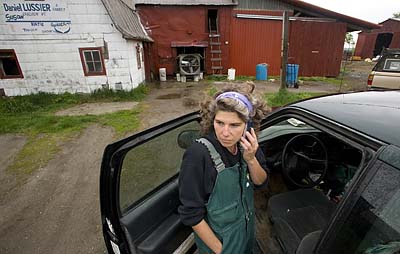
Bartholomew checks in with her office with at Lussier’s farm.
During Amy Bartholomew’s days on the road, agricultural economics is a distant second to the day-to-day needs of farmers, whether it’s doing pregnancy checks or treating sick animals.
Amy and veterinarian husband Rick opened Cold Hollow Veterinary Services, which also employs two other vets, almost seven years ago in Enosburg Falls, a town of about 1,500 in northwestern Vermont, just south of the Canadian border. The Bartholomews work exclusively with large animals: 70 percent dairy, 25 percent horses, and animals like llamas, alpacas, goats, and sheep.
Bartholomew is a native of Woodstock, Vt., and a child of musicians. She was drawn to becoming a vet, at least in part, by All Creatures Great and Small author James Herriot, the veterinarian whose heartwarming autobiographical stories of life in rural England also explained various veterinary procedures in great detail.
“I was 13, reading all these books. I said, ‘Wow, what a cool job,’” she said. She then started riding around with a vet in her area.
She was drawn to Bates by how warmly she was received while visiting the campus on a college swing through Maine. But her career goal left some College officials stumped. “They said they could get me into medical school but didn’t know anything about vet school,” she recalls.
That all changed in the mid-1990s, when, under its new chair, Associate Professor of Biology Lee Abrahamsen, the faculty’s Medical Studies Committee broadened its focus beyond just medical school. “It was very important to me that we expand the charge of the committee beyond just letter-writing and beyond just pre-meds,” Abrahamsen said. “We began to think about including all health-related fields.”
Today, some 150 Bates students seek the committee’s support each year, and about 50 students and alumni apply to health-related programs annually — most to medical school and the balance to veterinarian, dental, and physicians’ assistant or nursing programs. On average, 90 percent of those who apply are accepted.
When Bartholomew arrived at vet school, she found herself better prepared than some agriculture school graduates. “I had to work pretty hard at Bates,” she said. “I was accustomed to hard work.”
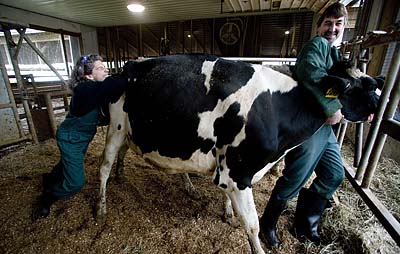
Green Mountain Farm herd manager Randy Collins (right) and Bartholomew maneuver a sick cow into position to be sedated and restrained for surgery.
That work ethic has stuck with her. She splits her time between the cows of Franklin County and helping raise her three elementary school-age kids. On an early April morning that more resembled November, Bartholomew checked 18 cows at the Green Mountain Dairy Farm in Highgate to see if they were pregnant — critical to the fortunes of a dairy farm that succeeds by keeping its cows pregnant and, after they give birth, producing milk.
Bartholomew grabs a handful of runny manure — “poor man’s lubricant,” she calls it — and reaches into a cow’s large intestine up to her shoulder, her arm covered by a clear plastic glove held in place by forceps. She feels for the uterus, and what she feels will tell her how advanced the pregnancy is. Any cows not pregnant must be rebred as soon as possible.
After spending the morning at Green Mountain, Bartholomew does an unofficial consultation in a convenience store parking lot with a client who is hoping goats can provide the income his cows don’t.
She watches as the farmers struggle to survive. “They are so far in debt,” she said. When a farmer sells out, creditors like Cold Hollow Veterinary Services “get a percentage of nothing.”
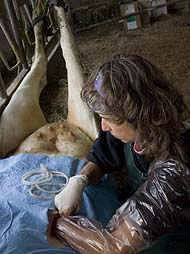
Bartholomew operates on a cow with a displaced abomasum, the stomach’s fourth compartment.
She eats as she drives her pickup truck with one hand and consults with the office on her cell phone. After lunch she spends an hour or so pregnancy-checking three alpacas for a family that raises the animals, native to South America’s Andes Mountains, for their wool.
Bartholomew loves treating cows and working with the farmers, and the work is plentiful. But alpaca owners and other non-dairy clients, often hobbyists with solid financial means, keep the income stream steady, especially during the winter months, which are tough on dairy farmers.
Knowing their future in dairy could go bad, the Bartholomews are considering opening a traditional small-animal veterinary practice, where dog and cat owners pay as they go. But if they can, they want to stay with the large animals. Working with farmers whose lives depend on the animals she cares for is more than just a job, Bartholomew believes.
“You become involved with their business and with their lives,” she said. “These people become your family members.”
Wilson Ring ’79 lives in Waterbury Center, Vt., and is a reporter for The Associated Press. His freelance fee for this story, he says, will help pay his horses’ vet bills.